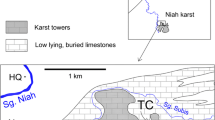Abstract
The caves that are present within the Injana Formation (Upper Miocene–Pliocene) which sometimes extend to be hosted within the Dibdibba Formation (Pliocene–Pleistocene) in the Tar Al-Najaf and Tar Al-Sayyed within the Najaf–Karbala district have been studied. The study aims to assess the genesis of caves and diagnose the factors affecting the building and the destruction of these caves through geologic time. For this reasons, intensive fieldwork as well as the mineralogical composition and microscopic interpretation were achieved to facilitate the investigation of cave-forming factors. Calcite, quartz, feldspar, dolomite, as well as clay minerals are the constituents of Injana Formation in the study area. The amount of insoluble residue is usually higher in weathered carbonates and in some other cases in fresh carbonate, which is not very common but it may occur. Caves appear to be hosted within the claystone beds and concentrated within Injana Formation, whereas the Dibdibba Formation seems to form the roof of the caves. The mechanism of building caves starts by microdissolution forming microfractures. Then with time, they have developed to be vertical joints. These joints were gradually enlarged as a result of claystone exfoliation along joint planes. Chemical weathering, physical weathering, and sedimentary structure (mud balls) play a key role in the processes of cave evolution. Some caves appear to be irregular, but others tend to be regular with rectangular shape, enough for hosting human beings. These caves may have been used as homes for the ancient human for his protection and improvement of his life. At the same time as the caves were formed, there were other natural factors working continuously that destroy the cave. These factors are dissolution, soil creep, and mass sliding. This work highly recommends for further contributions in terms of the archaeological investigation on these caves to discover the ancient civilization in this area, if any.










Similar content being viewed by others
References
Adelbro C (2003) Rock mass strength. A review. Technical Report. Lulea University of Technology, Department of Civil Engineering, 15 pages
Al-Hashimi HA (1973) The sedimentary facies and depositional environment of the Eocene Dammam and Rus Formations. J Geol Soc Iraq 6:1–18
AL-Hussayni RM (2011). Slope stability study of selected sites from Tar Al–Sayyed Area in Karbala Governorate, Middle of Iraq. M Sc thesis, University of Baghdad. 120 pages
Al-Mehaidi HM Vejulpex M, Avel Yacoub SY (1975) Report on regional geological mapping Shithatha–Habbaniya area, GEOSERV, Baghdad, no. 679
Al-Sayyab A Al-Ansari N, Al-Rawi D, Al-Jassim, JA, Al-Omari, F. and Al-Sheikh, Z (1982) Geology of Iraq. Mousl University Print, 277 pages.
Aqrawi AA, Horbury AD, Goff GC, Sadooni FN (2010) The petroleum geology of Iraq. Scientific Press, UK, 424 pages
Barwary AM and Naseira AS (1995) The geology of Al-Najaf quadrangle, State Establishment of Geological Survey and Mining, (Internal report). pp. 20–23.
Bathurst RG (1975) Carbonate sediments and their diagenesis. Second enlarged edition. Elsevier, Amsterdam, p 658
Bellen RC, Dunnington HV, Wetzel R and Morton D, 1959. Lexique Stratigraphique, Interntional. Asie, Iraq, vol. 3c. 10 a, 333 pages
Buday T (1980) The regional geology of Iraq. Stratigraphy and Paleogeography. Publ. of GEOSURV, Baghdad, Vol. 1, 445 pages.
Dawood RM (2000) Mineralogy, origin of celestite and the factors controlling its distribution in Tar Al–Najaf, Najaf Plateau. Msc. Thesis, Baghdad University, Iraq.
Dunnigton HV (1958) Generation, migration, accumulation and dissipation of oil in north Iraq. In Weeks, L. G. (ed), Habitate of oil, a symposium, AAGP, spec. pub., pp.1194–1251.
Gayara AD (1976) Geology of the parts of khanuqa and Makhoul anticlines, North-Central Iraq. Unpub M. Sc. Thesis. University of Baghdad, Iraq
Guerriero V, Hing D, Jemi I (2011) Improved statistical multi-scale analysis of fractures in carbonate reservoir analogues. Tectonophysics (Elsevier) 504:14–24. doi:10.1016/j.tecto.2011.01.003
Hamza NM (1975) Report on regional geological mapping Al-Thrthar-Hit-Qasr Al-Khubbaz area. NIMCO, Library, Baghdad, no. 678.
Hassan KM (2007) Stratigraphy of Karbala-Najaf Area, Central Iraq. Iraqi Bulletin of Geology and Mining 3(2):53–62
Hassan AN and Al-Jawadi BM (1967) Geology of Samarra-Baiji area GEOSERV Int. Report. Baghdad, Iraq
Hassan KM, Al-Khateeb A (2005) Piping and cave forming claystone-Injana formation, Karbala-Najaf area. Iraqi Geological Journal 34–38(1):153–162
Jassim SZ, Goff JC (eds) (2006) Geology of Iraq. Published by Dolin, Prague and Moravian Museum, Brno, p 341P
Jassim, SZ, Karim SA, Mubarak I, Basi M and Munir J (1984) Final report on the regional geological survey of Iraq. V.3: Stratigraphy. GEOSURV, Internal. Rep. No.L447.
Kukal ZB, Saadalla A (1970) Paleocurrents in Mesopotamian Geosyncline. Sonder Druk Aus der Geologischen Rundschea Band 59:666–680
Lateef AS (1975) The geological mapping of Hamrin from Al-Fatha to Ain Layla area, GEOSERV Int. Report. Baghdad, Iraq.
Nadja ZH (2002) Chemical weathering of limestones and dolomites in a cave environment. Evolution of karst: from prekarst to cessation. Postojna-Ljubljana, Zalozba ZRC, 347–356.
Roberts JC (1995) Fracture surface markings in Liassic limestone at Lavernock Point, South Wales. Geological Society, London, Special Publications; v. 92; p. 175–186
Rose AW, Hawkes HE, Webb JS (1981) Geochemistry in mineral exploration, 2nd edn. Academic press, London, 657p
Sissakian V (1999) The Nfayil Formation, GEOSURV., Internal repert, Baghdad, Iraq. Bghadad.
Summerfield MA (1991) Global geomorphology, an introduction to the study of landforms. Wiley, New York, p 537
Tamar-Agha MY, Al-Mubarak M, Al-Hashimi (1997) The Jil Formation, a new name for the Early Eocene litho-Stratigraphic Unit in South of Iraq. Iraqi Geol Jour 30(1):37–45
Thomas H, Behnam HA, Ligabue G (1981) New formation, discoveries of vertebrate fossils in the Bakhtiari Formation, Injana area, Himrin, South Iraq. Jour Geol Soci Iraq 14:43–54
Author information
Authors and Affiliations
Corresponding author
Rights and permissions
About this article
Cite this article
Awadh, S.M., Abood, Z.S. & Eisa, M.J. Chemical and physical control processes on the development of caves in the Injana Formation, Central Iraq. Arab J Geosci 6, 3765–3772 (2013). https://doi.org/10.1007/s12517-012-0637-z
Received:
Accepted:
Published:
Issue Date:
DOI: https://doi.org/10.1007/s12517-012-0637-z




